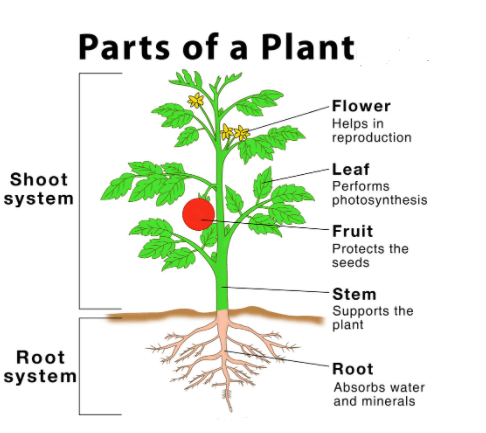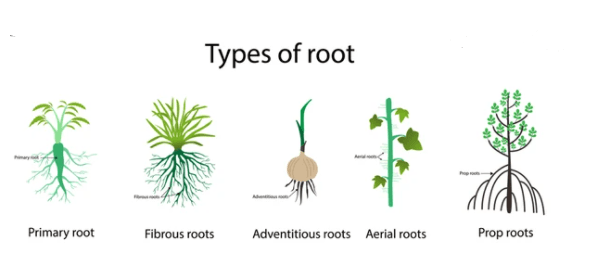Parts of a Plant
Like humans, plants are also living beings that need a certain habitat for their proper growth. they need a proper distance, food, and light energy through the photosynthesis process. however, these all things are carried to the plant through its different parts. A careful study of the plant reveals that there are six basic Parts of a Plant such as roots, stems, leaves, flowers, fruits, and seeds.

What are the parts of a plant?
There are six important parts of a plant which are as follows:
- Stem
- Root
- Leaves
- Flower
- Seed
- Fruit
See Also: Calvin Cycle
Stem
the stem is known as the ariel part of the plant that provides the structure as well as support to the plant. it is also important for supporting other parts and organs such as leaves and flowers. the stem has negative geotropism that means the growth of the plant carried the opposite direction of the force of gravity due to the stem. there are several types of stems having different characteristics and functions which will be discussed below.

Types of Stem
we can categorize types of stems in different ways but the most common is known according to the aerial stems. they are underground stems.
- tubers, rhizomes, and bulbs are three major types of underground stems.
- underground stems are a special type that can be differentiated into climbing, erect, creeping, and voluble,
Functions of Stem
the major functions of the stem are to provide support and shape to the whole aerial part of the plant. they also provide nutrients and other substances to the inside of the plant. raw sap rises up to the leaves through roots to the stem ducts and from nowhere they convert into carbon dioxide and rise elaborated sap to the whole plant.
See Also: Carbon cycle
Root
the root plays a feeder role to the whole plant. it is an underground branched part that feeds the plant. these are known as the first organ that a plant develops in the process of seed germination.

Types of Root
There are several types of roots, which can be classified in different ways:
Types of roots according to the anchor they provide to the plant:
- Contractile roots
- Epiphytic roots
- Stilts
Types of roots according to their shape:
- Axonomorphic roots
- Napiform roots
- Fasciculated roots
- Tuberous roots
- Branched roots
Types of roots according to the direction of growth:
- Adventitious roots
- Storage roots
- Aquatic roots
- Aerial roots
- Sucking roots
Functions of Root
- they absorb water and nutrients with the help of absorbent hairs.
- they provide or spread the food to the rest of the plant through the stem.
- with aerial roots and underground roots, they anchor the structure of the plant to the environment.
- some roots can do photosynthesize or stick to other plants to absorb nutrients.
Leaves
they are well recognized and shining parts of the plant. they have a great diversity of shapes, colors, and sizes. leaves are almost part of every single plant. they have a major function in photosynthesis. they are usually green in color and are very tiny as compared to the whole plant that grows with the stem branches.
See Also: Nitrogen Cycle
What are the types of leaves?
Leaves can be classified in many different ways: according to their petiole, their edge, their rib, or even their shape. Its most elementary and basic classification, on the other hand, is based on whether the plant keeps the leaves all year round, and they are perennial, or if it loses them in the cold months, and they are deciduous. Learn more about the types of leaves here.
functions of a Leaf
- they carry the photosynthesis process by obtaining the chemical energy from sunlight.
- leaves exchange the gases at night and also helps to breathe the plant.
- they let plants access water escape and perspire.
See Also: Internal Structure of a Leaf
Flower
the flower is known as one of the showiest parts of a plant. it is a more attractive part to the people. the reproduction process occurs in the flower of the plant. they are so bright in color that causes the attraction of pollinating insects towards them. it is the most common truth that all the plants are reproduced by the flowers.
What are the types of flowers?
the flowers have immense diversity in their types. they can be found in different shapes, sizes, colors, and especially aromas.
Parts of the flower
has five major parts such as calyx, corolla, filament, stamens, and pistils. the pollen (a male sexual organ of the plant) is found in stamens which are later carried to the pistils (a female plant sexual organ). here it gives rise to the process of creation of a new plant.
Fruit
it is not necessary for all the plants to have fruits. only those plants have fruits that are reproduced sexually by seeds. in fertilization of flower, the seed is produced which tend to form the fruit around it.
Types of fruits
same with flowers and leaves, there are several types of fruits. in fact, any fruit which you eat belongs to a plant or tree. there are some fruits called nuts or dry fruits.
Functions of fruits
the major function of fruit is to protect the seed and also facilitate its dispersal through any animal activity. the animals consume fruits and collect their seeds into their stomachs. later on, they spread these seeds to different places.
FAQ’s (Frequently Asked Questions)
What are the main parts of a plant and their functions?
Basically, there are six major parts of a plant such as roots, stems, leaves, flowers, fruits, and seeds. each part has its own function, for example, the flower help in the reproduction of the plant, the leaf performs photosynthesis with the help of sunlight, fruit protects the seed, the stem supports the plant, the root absorbs the water and different mineral for the plant growth, the seed is a major element for plant reproduction.
What is each part of a plant for?
we consider the three major parts which are Roots, Leaves, and Stem. each part performs a different action for the development and growth of the plant.
What are the four main structures of a plant?
the four main structures are:
- root system
- a stem or trunk
- branches
- leaves, and reproductive structures
You May Also Like:


